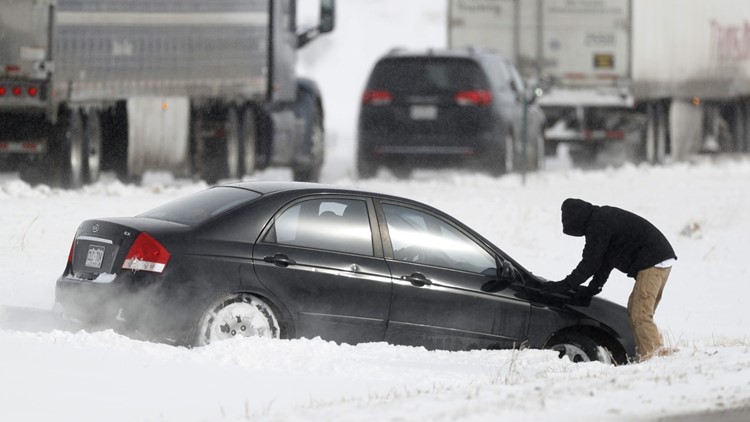 A motorist struggles to free his sedan after sliding off Interstate 70 in Aurora, Colo., Tuesday, Oct. 29, 2019. (AP Photo/David Zalubowski)
A motorist struggles to free his sedan after sliding off Interstate 70 in Aurora, Colo., Tuesday, Oct. 29, 2019. (AP Photo/David Zalubowski)
The parts of the United States that have been experiencing an extended warm fall are about to receive a brutally cold 1-2 punch this weekend and into next week.
A weak storm will first dive southward from Canada into the central U.S. this weekend as temperatures continue to nosedive, with freezing weather predicted to take aim nearly all the way to the Gulf Coast, according to AccuWeather meteorologists.
By early next week, a storm is expected to gather in the center of the country, helping to pull down even more cold air across the United States, according to AccuWeather meteorologists. In addition to providing more wintry precipitation from places like Texas to Massachusetts, the storm also will bring an even stronger push of cold.
Over the first couple of days of next week, most communities in the eastern two-thirds of the nation could be at least 10-20 degrees below normal for mid-November, according to AccuWeather meteorologists.
"While the extreme cold is expected to give way to a milder pattern to close out November, it may take until the week of November 18-22 to clear out the well below-normal temperatures from the northern Plains through the Great Lakes," said AccuWeather Lead Long-Range Meteorologists Paul Pastelok.

To this point, estimated heating costs for numerous major U.S. cities are below normal for this time of year, according to an AccuWeather analysis.
Washington, D.C. (41.9% lower), Boston (35.5%), New York City (33.3%), and Philadelphia (32.9%) have experienced significantly lower estimated heating costs compared to normal for the period from Sept. 1 through Nov. 5. Those cities' estimated costs are also lower than last year: Washington (26.9% lower), New York City (25.4%), Philadelphia (25.1%) and Boston (20.9%).
Other cities with higher-than-normal temperatures and the resulting lower estimated heating costs compared to normal include Cincinnati (25.9% lower), Detroit (16.6%) and Indianapolis (14.4%). They're also lower than last year: Cincinnati (23.2% lower), Detroit (20%) and Indianapolis (15.6%).
However, AccuWeather predicts several of those U.S. cities will see greatly elevated heating costs compared to normal over the next week, ending Nov. 15.
New York City's estimated heating costs will change from 33.3% lower than normal to just 8.9% lower by Nov. 15 as the temperatures drop. Costs in Philadelphia will go from 32.9% lower to 8.0% below normal and estimated costs in St. Louis, which were 8.6% above normal through Nov. 5, will go to 34% above normal by Nov. 15.
Other cities facing a swing in estimated heating costs include Boston, which will go from 35.5% below normal to 15.9% below normal, and Chicago, with its estimated heating costs going from 2.3% below normal on Nov. 5 to 12.1% above normal by Nov. 15. (Download the free AccuWeather app to track the temperature for your area.)
Colder temperatures have already impacted some cities, however, as estimated heating costs are above normal from Sept. 1 through Nov. 5. Oklahoma City (79.1% higher), Salt Lake City (36.9%), Portland, Oregon (25.9%) and Denver (22.8%) stand out in particular. Those cities' estimates are higher than last season, too: Portland (68% higher), Salt Lake City (63.5%), Oklahoma City (28.1%) and Denver (23.9%).
The heating season typically runs from Sept. 1 until the following April. The costs of heating, including electricity, vary from year to year and from place to place, so the percentage change in your bill may vary from these percentages.
Download the free AccuWeather app to track the temperature for your area. Keep checking back for updates on AccuWeather.com and stay tuned to the AccuWeather Network on DirecTV, Frontier and Verizon Fios.



